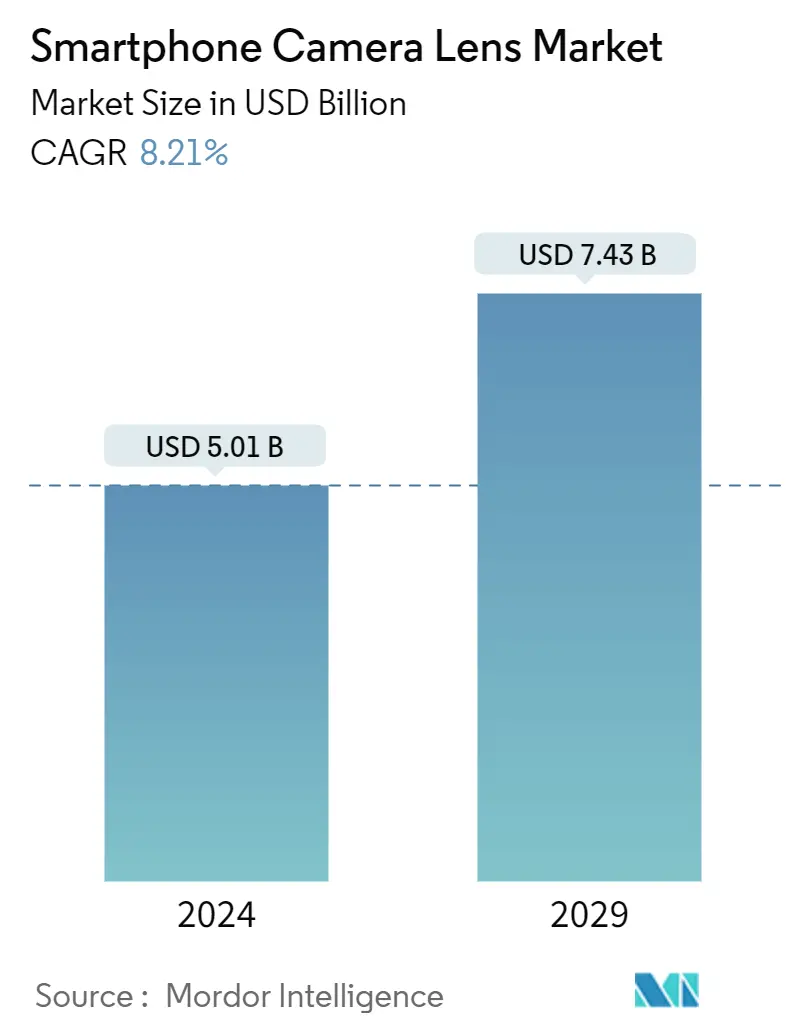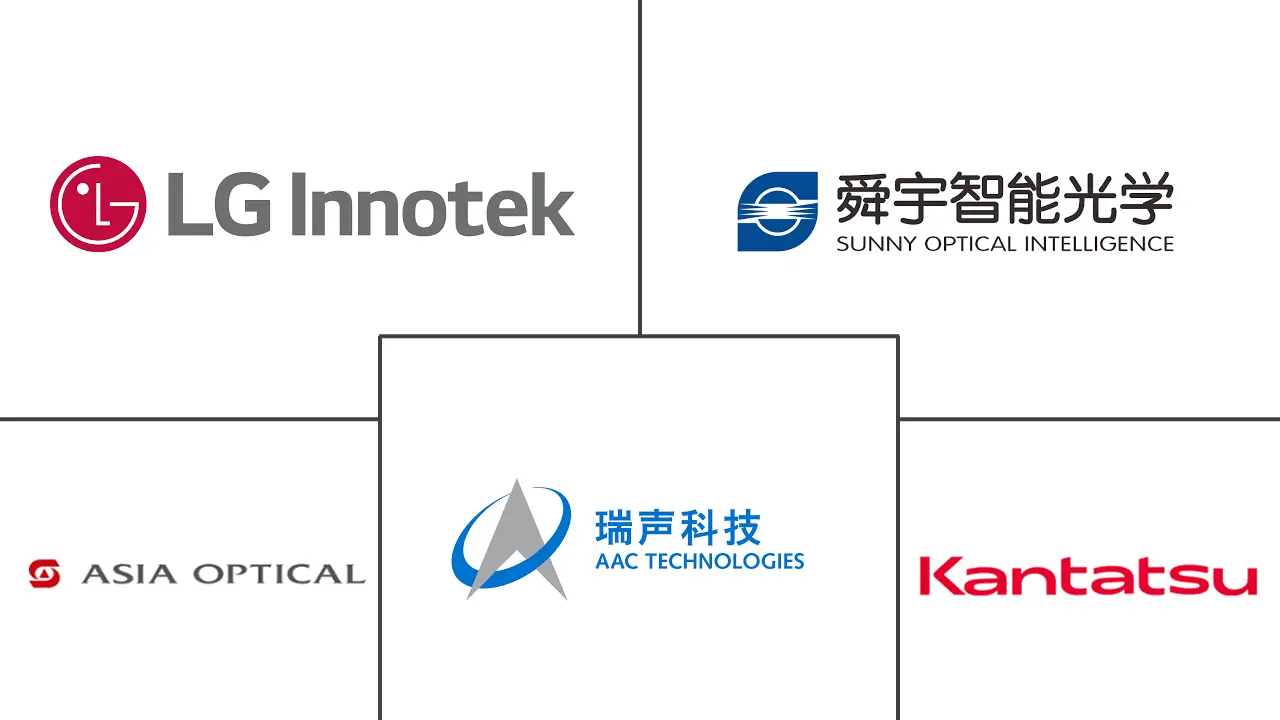Market Size of Smartphone Camera Lens Industry

| Study Period | 2019-2029 |
| Market Size (2024) | USD 5.01 Billion |
| Market Size (2029) | USD 7.43 Billion |
| CAGR (2024 - 2029) | 8.21 % |
| Fastest Growing Market | Asia Pacific |
| Largest Market | Asia Pacific |
Major Players
*Disclaimer: Major Players sorted in no particular order |
Smartphone Camera Lens Market Analysis
The Smartphone Camera Lens Market size is estimated at USD 5.01 billion in 2024, and is expected to reach USD 7.43 billion by 2029, growing at a CAGR of 8.21% during the forecast period (2024-2029).
The market is witnessing various advancements related to the different types of lenses being used in smartphones. Various smartphone manufacturers are developing smartphones with multiple cameras that include other types of lenses, including telephoto lenses, macro lenses, and ultra-wide-angle lenses.
- The lenses of smartphone cameras refer to the optical components integrated into the camera modules of smartphones. These lenses combine with sensors and image-processing algorithms to capture photos and videos. A single lens typically comprises multiple glass or plastic elements arranged in a specific configuration to achieve the desired optical performance. Combining multiple lenses with different focal lengths and functionalities helps smartphone users capture a wide range of images without using external attachments.
- With rapidly increasing technological developments in smartphones, the adoption of camera lenses has been continuously rising, thereby pushing the market players to invest in this technology through product innovations, expansion activities, mergers, acquisitions, collaborations, and partnerships. For instance, in January 2023, Samsung Electronics announced the launch of its latest image sensor, the ISOCELL HP2, which entails a 200-megapixel resolution. According to Samsung, the lens will offer improved pixel technology for better image quality in its premium smartphones.
- Growing regional economies and rising disposable incomes in emerging markets have led to a surge in the global demand for smartphones. With each new generation of smartphones, there are new advancements in the capabilities of the cameras. Consumers increasingly prioritize the quality of a phone's camera while purchasing a new one. Thus, manufacturers are investing in improving the performance of camera lenses in mobile phones.
- Over the recent years, the smartphone market has witnessed a decline in sales. Several factors have contributed to this decline, including reduced demand from customers, economic uncertainties, and global inflation.
- The outbreak of the COVID-19 pandemic has left a notable dent in the market as various containment measures taken by governments across multiple countries, such as the implementation of lockdowns, significantly impacted the growth of the industry. As a result, a slowdown was witnessed in the market, especially during the initial phase of the pandemic. The COVID-19 pandemic impacted the global sales of smartphones. This situation also posed several challenges to the industry. Lockdowns and economic uncertainties led to consumers spending less on non-essential products, thereby resulting in a decrease in the demand for smartphones.
Smartphone Camera Lens Industry Segmentation
A smartphone camera lens is an optical lens or an assembly of lenses used in association with a camera body that is meant for a smartphone. It has the mechanism to make images of objects either on a photographic film or on other media capable of chemically or electronically storing an image. A lens plays a crucial role in image quality and versatility, thereby allowing users to capture diverse shots ranging from wide landscapes to portraits with close-up details.
The smartphone camera lens market is segmented by geography (Asia-Pacific, Americas, Europe, and Rest of the World). The market size and forecasts of all the above segments are provided in terms of their respective values (in USD).
| By Geography | |
| Asia-Pacific | |
| Americas | |
| Europe | |
| Rest of the World |
Smartphone Camera Lens Market Size Summary
The smartphone camera lens market is experiencing significant growth, driven by advancements in lens technology and the increasing integration of multiple camera systems in smartphones. Manufacturers are focusing on developing smartphones with diverse lens types, such as telephoto, macro, and ultra-wide-angle lenses, to enhance photographic capabilities. This trend is fueled by the rising consumer demand for high-quality camera features in smartphones, prompting companies to invest in innovative lens technologies and strategic partnerships. The market is characterized by rapid technological developments, with major players like Samsung Electronics introducing advanced image sensors to improve image quality in premium devices. Despite challenges such as declining smartphone sales and the impact of the COVID-19 pandemic, the market continues to expand as consumers prioritize camera quality in their purchasing decisions.
The Asia-Pacific region plays a pivotal role in the smartphone camera lens market, driven by its robust manufacturing base and growing consumer demand for high-resolution cameras. Countries like China and India are at the forefront, with significant production volumes and investments in advanced mobile networks. The region's favorable conditions, including abundant raw materials and cost-effective labor, attract companies to establish production facilities, further boosting market growth. The fragmented market landscape features numerous players, such as LG Innotek and Sunny Optical Technology, who are actively innovating and forming strategic alliances to maintain their competitive edge. As smartphone brands continue to introduce models with advanced camera features, the demand for sophisticated camera lenses is expected to rise, supporting the market's expansion over the forecast period.
Smartphone Camera Lens Market Size - Table of Contents
-
1. MARKET INSIGHTS
-
1.1 Market Overview
-
1.2 Industry Attractiveness - Porter's Five Forces Analysis
-
1.2.1 Bargaining Power of Suppliers
-
1.2.2 Bargaining Power of Buyers
-
1.2.3 Threat of New Entrants
-
1.2.4 Threat of Substitute Products
-
1.2.5 Intensity of Competitive Rivalry
-
-
1.3 Impact of COVID-19 Aftereffects and Other Macroeconomic Factors on the Market
-
-
2. MARKET SEGMENTATION
-
2.1 By Geography
-
2.1.1 Asia-Pacific
-
2.1.2 Americas
-
2.1.3 Europe
-
2.1.4 Rest of the World
-
-
Smartphone Camera Lens Market Size FAQs
How big is the Smartphone Camera Lens Market?
The Smartphone Camera Lens Market size is expected to reach USD 5.01 billion in 2024 and grow at a CAGR of 8.21% to reach USD 7.43 billion by 2029.
What is the current Smartphone Camera Lens Market size?
In 2024, the Smartphone Camera Lens Market size is expected to reach USD 5.01 billion.

